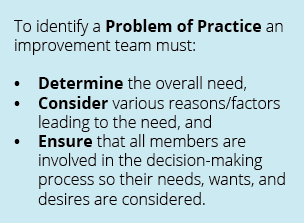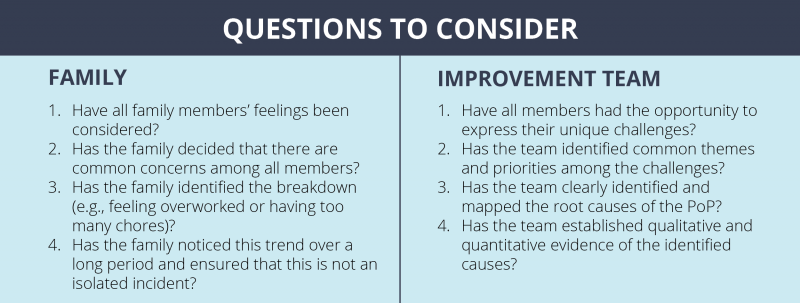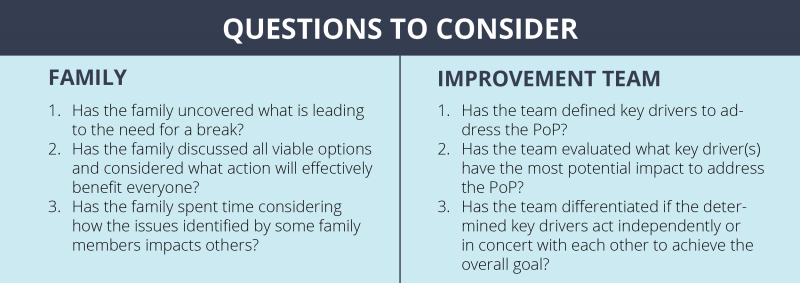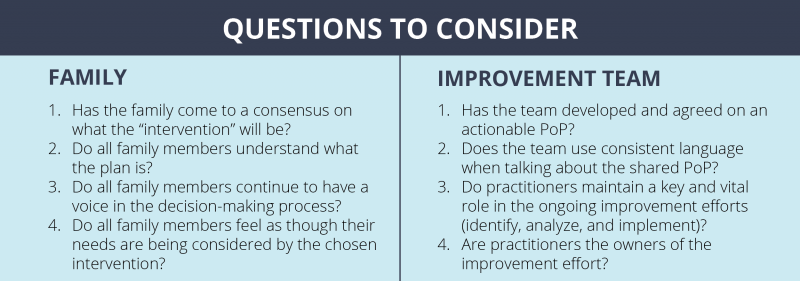Change Management: Identifying a Problem of Practice
By Peter Lorinser, Improvement Specialist at the Rennie Center
This the first of a series of blog posts on the six essential elements of improvement outlined in the Rennie Center’s Change Management Framework.
As families across the nation nestle back into the routine of another school year, many will return reinvigorated, refreshed, and ready to get back to work. But a few months later some students and parents will find themselves thinking longingly about the summer. Facing new or returning frustrations, some might say, “I need another vacation!”
When a break or change is needed, a vacation is often the first thing we consider. But vacations aren’t the only way to relax or refocus. A variety of options are worth considering, including some that may be more effective and cost-efficient—like a massage, a long walk, or even a new morning routine. Further, if we don’t take the time to deeply consider the source of our frustrations, the change we desire is unlikely to occur. A vacation may simply be an expensive and time-consuming way to ignore a problem, when a more significant and life-altering change, like a new job, is needed.
Just like a family that wants to get away, schools and districts often feel the need for change. However, making changes is not the same thing as improving practice. The best solutions are not always clear from the start. Some problems require robust remedies, while others only need gentle tweaking. When we jump into change without taking the time to identify and fully think through the problem we’re attempting to solve, we’re unlikely to produce the outcomes we hope to achieve. More often, our impetuousness will lead to misaligned incentives, misallocated resources, and increased frustration.
Effective improvement projects begin by identifying an actionable Problem of Practice (PoP). At the surface level, this is as simple as defining why there is a need for improvement, who is involved, and how they will be impacted. The process, on the other hand, is often far from simple.
Defining a problem of practice is at the heart of the Rennie Center’s Change Management Framework, a six-part process to guide sustainable improvement. Through our experience and that of the Massachusetts Teaching and Learning Networks (MassTLN), we have learned that to ensure the sustainability of improvement efforts, implementing teams must pursue the following actions in identifying a PoP:
- DEVELOP A CLEAR UNDERSTANDING OF THE NEED
- DEFINE THE UNDERLYING REASONS
- ENSURE CONSISTENT CONSIDERATION OF THOSE INVOLVED
1. DEVELOP A CLEAR UNDERSTANDING OF THE NEED | Identify challenges and causes of the problem of practice (PoP) through collective and systematic analysis led by practitioners.
Feeling the need for a vacation, or a break from the status quo, is just the first step in identifying a problem. Potential solutions must be closely aligned with the needs they seek to address. Without such alignment, improvement is unlikely. A family may wish to take a vacation to relieve stress, for example, but if the source of this stress is financial difficulties, a potentially expensive getaway may only exacerbate the problem.
Similarly, teams engaged in improvement efforts should conduct a thorough analysis to fully understand why change is needed before altering practice. This work includes seeking input from a diversity of voices regarding the problem at hand, analyzing these perspectives to produce common themes, and then mapping and consolidating these themes. The result is a clear PoP that can be substantiated by quantitative and qualitative data. This work should be led by school-based practitioners, who are on the front lines of improvement efforts and best positioned to collect and analyze data explaining the local context.

2. DEFINE THE UNDERLYING REASONS | Determining an inter-related set of hypotheses about key drivers for improvement.
If a family does decide that it’s time for a vacation, they should look at all the causes leading to their need to get away and consider what kind of trip will benefit each member of the family. Choosing the wrong solution—like going to an amusement park when the family needs some time to relax—may leave some family members frustrated and unfulfilled.
Before an improvement team can select an intervention, it must understand the existing practices leading to the problem. This will enable the team to eventually identify strategies that are likely to have the highest impact. In the end, an effective solution focuses on the source of the problem, rather than just the action to be taken. The Rennie Center’s new book, Improving Education Together: A Guide to Labor-Management-Community Collaboration, includes a number of resources to help change agents develop a full picture of the problems they hope to address (p. 80-82).

3. ENSURE CONSISTENT CONSIDERATION OF THOSE INVOLVED | Build ownership and buy-in around PoP from practitioners and key stakeholders responsible for executing and managing drivers for improvement.
Have you ever been on a family trip and no one wants to do what you want? You want to go hiking, and you found a great path, but your family decides to go white water rafting instead. You planned carefully, got to the right place at the right time, and are in the right environment, but your perspective seems lost in what everyone else wants to do. Getting thrown around by rapids was never your idea of relaxation. This can be frustrating and disempowering. You begin to think, “Isn’t this break supposed to be for me, too?”
Failing to respond to the needs of all family members is analogous to ignoring the input of practitioners in an improvement effort. To build an effective improvement strategy, a team of practitioners must coalesce around a shared PoP. The group needs to consider how that problem is perceived by everyone involved and work with those responsible for sustaining the work, including teachers, principals, support staff, parents, and community members. As the team works to define a problem of practice, individual members may have different preferences and priorities. But, ultimately, all team members must agree on a way forward that best addresses the needs of the entire group. As the improvement effort unfolds all team members should feel ownership of the effort.

From ideation through planning to implementation, improvement efforts require a secure foundation. Effective improvement projects benefit immensely from spending time, effort, and resources up front on developing a Problem of Practice. Planning teams must consider the current challenges that the team faces and work to identify the key drivers that are likely to have the highest impact on desired improvements. This process should be open, transparent, and informed by practitioners responsible for executing and managing the proposed work. Further, sustained commitment can only be assured by continuously seeing to the collective ownership and buy-in of the improvement effort by practitioners.
Identifying the need for a break, considering the reasons for the need, and keeping the needs of all family members in mind throughout the process can prevent a family from feeling like they “need a vacation from vacation!” Doing the same for an improvement effort will combat improvement burnout and set a secure foundation for success.
OUR CHANGE MANAGEMENT TOOLS
Identify a problem of practice. Establish projected outcomes. Detail the nature of intervention. Build a trusting and committed team. Establish effective operations. Support systemic and continuous learning cycles. Each step sounds simple enough on the surface, but the devil is in the details. We’re here to help. Our rubrics provide detailed assessment tools to help teams think through each step of the process. We hope our expertise can benefit those looking to make improvements in their districts, schools, or networks. Our specialists can help teams utilize tools, collect data, build capacity to analyze the information and devise course corrections, and disseminate and scale findings. If you’re interested in learning more, please contact Rennie Center Director of Implementation Juanita Zerda.
Problem of Practice Resources
- Fishbone Diagram (protocol from the Innovation Center).
- Driver Diagram | How Do You Use a Driver Diagram? Don Goldmann, MD, Chief Medical and Scientific Officer, Institute for Healthcare Improvement
- Understanding the Challenge
- Improving Education Together Resources
References
- Marietta, G., d'Entremont, C. & Kaur, E. M. (2017). Improving Education Together: A Guide to Labor Management Community Collaboration. Cambridge, MA: Harvard Education Press.
- Columbus City Schools. (n.d.). "Identifying a 'Problem of Practice'".
- Fixsen, D., Naoom, S., Blase, K., Friedman, R., Wallace, F. (2005). Implementation Research: A Synthesis of the Literature. Tamps, FL: University of South Florida, Louis de la Parte Florida Mental Health Institute, National Implementation Research Network.
- Wenger, E. (1999). Communities of Practice: Learning, Meaning, and Identity. Cambridge, MA: Cambridge University Press.
